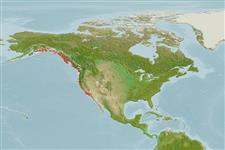>
Acipenseriformes (Sturgeons and paddlefishes) >
Acipenseridae (Sturgeons) > Acipenserinae
Etymology: Acipenser: Latin, acipenser = sturgeon, 1853 (Ref. 45335); medirostris: The specific name is derived from medirostris, referring to its moderate snout (Ref. 1998).
More on author: Ayres.
Environment: milieu / climate zone / profondeur / distribution range
Écologie
marin; eau douce; saumâtre démersal; anadrome (Ref. 120652); profondeur 0 - 80 m (Ref. 50610). Temperate; 10°C - 20°C (Ref. 2059); 65°N - 32°N, 166°W - 114°W (Ref. 54261)
North America: Aleutian Islands and the Gulf of Alaska to Ensenada, Mexico. Considered vulnerable in Canada. The Asian population is now considered to be a separate species Acipenser mikadoi (Ref. 6866).
Length at first maturity / Taille / Poids / Âge
Maturité: Lm ?, range 162 - ? cm
Max length : 270 cm TL mâle / non sexé; (Ref. 96339); common length : 130 cm TL mâle / non sexé; (Ref. 12193); poids max. publié: 159.0 kg (Ref. 2850); âge max. reporté: 60 années (Ref. 72476)
Description synthétique
Clés d'identification | Morphologie | Morphométrie
Épines dorsales (Total) : 0; Rayons mous dorsaux (Total) : 33 - 35; Épines anales: 0; Rayons mous anaux: 22 - 28. Characterized by a single row of 1 to 4 bony plates along the midventral line between the anus and the anal fin, and about 33 to 35 rays in the dorsal fin. Dorsal arises at posterior third of the total length; anal fin arises under posterior part of dorsal; pectorals originate low on the body just behind gill opening and are large and rounded; pelvic fins arise near the anus. Generally olive to dark green, lower parts more or less whitish green; a longitudinal olive-green stripe on side between lateral and ventrolateral plates, another on midventral surface; fins grayish to pale green (Ref. 27547). Barbels usually situated closer to mouth than to snout tip; coloration of scutes along side paler than skin (Ref. 86798).
Body shape (shape guide): elongated.
Found in estuaries, lower reaches of large rivers, and in salt or brackish water off river mouths (Ref. 5723). Probably spawns in fresh water (Ref. 27547). May cover considerable distances in the ocean (Ref. 27547). Edible but with a disagreeable taste and unpleasant odor (Ref. 1998).
Page, L.M. and B.M. Burr, 1991. A field guide to freshwater fishes of North America north of Mexico. Houghton Mifflin Company, Boston. 432 p. (Ref. 5723)
Statut dans la liste rouge de l'IUCN (Ref. 130435: Version 2025-1)
Menace pour l'homme
Harmless
Utilisations par l'homme
Pêcheries: intérêt commercial mineur; pêche sportive: oui
Outils
Articles particuliers
Télécharger en XML
Sources Internet
Estimates based on models
Preferred temperature (Réf.
123201): 9.1 - 12.7, mean 10.6 °C (based on 50 cells).
Phylogenetic diversity index (Réf.
82804): PD
50 = 0.5000 [Uniqueness, from 0.5 = low to 2.0 = high].
Bayesian length-weight: a=0.00389 (0.00180 - 0.00842), b=3.12 (2.94 - 3.30), in cm total length, based on all LWR estimates for this body shape (Ref.
93245).
Niveau trophique (Réf.
69278): 3.5 ±0.52 se; based on food items.
Generation time: 12.6 ( na - na) years. Estimated as median ln(3)/K based on 1
growth studies.
Résilience (Réf.
120179): Faible, temps minimum de doublement de population : 4,5 à 14 années (K=0.05-0.09).
Fishing Vulnerability (Ref.
59153): Very high vulnerability (80 of 100).
🛈
Climate Vulnerability (Ref.
125649): High to very high vulnerability (67 of 100).
🛈
Nutrients (Ref.
124155): Calcium = 14.8 [9.0, 24.9] mg/100g; Iron = 0.253 [0.156, 0.390] mg/100g; Protein = 17.7 [15.1, 20.3] %; Omega3 = 0.354 [0.202, 0.615] g/100g; Selenium = 22.6 [12.6, 42.8] μg/100g; VitaminA = 4.61 [1.77, 11.95] μg/100g; Zinc = 0.437 [0.320, 0.597] mg/100g (wet weight);
